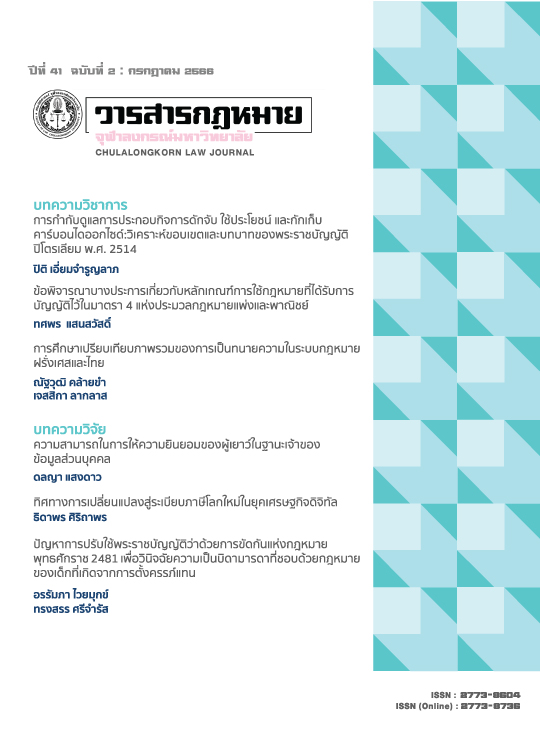A Brief Commentary on the Methods of Application of Law stipulated in Section 4 of the Civil and Commercial Code
Main Article Content
Abstract
This academic paper has a purpose to inquire whether there exists in the Thai legal system any legal provision which specifically stipulated “methods of interpretation of law”. The analysis focuses mainly on the concrete rules for applying the law provided by Section 4 of the Civil and Commercial Code. The results suggest that Section 4 of the Civil and Commercial Code is not a provision which laid down the “methods of interpretation of law” of the Thai legal system, but rather a provision regarding the “application of law”, that is, the provisions which determines the applicable scope of law, sources of law in the Thai legal system and the sequence of application, as well as recognized expressis verbis a methodological solution to the gap of law called “analogy”. In addition, this article contains an analysis of the logical connection between both subsections of Section 4 of the Civil and Commercial Code, delineated through the concept of the fulfilment of “the gap in the law”, as well as discusses certain principles to be relied upon when a gap or potential gap in the law was found.
Article Details

This work is licensed under a Creative Commons Attribution-NonCommercial-NoDerivatives 4.0 International License.
The copyright in this website and the material on this website (including without limitation the text, computer code, artwork, photographs, images, music, audio material, video material and audio-visual material on this website) is owned by Chulalongkorn Law Journal and its licensors.
1. Chulalongkorn Law Journal grants to you a worldwide non-exclusive royalty-free revocable license to:
- view this website and the material on this website on a computer or mobile device via a web browser;
- copy and store this website and the material on this website in your web browser cache memory; and
- print pages from this website for your use.
- All articles published by Chulalongkorn Law Journal are licensed under the Creative Commons Attribution 4.0 International License. This permits anyone to copy, redistribute, remix, transmit and adapt the work provided the original work and source is appropriately cited.
2. Chulalongkorn Law Journal does not grant you any other rights in relation to this website or the material on this website. In other words, all other rights are reserved. For the avoidance of doubt, you must not adapt, edit, change, transform, publish, republish, distribute, redistribute, broadcast, rebroadcast or show or play in public this website or the material on this website (in any form or media) without appropriately and conspicuously citing the original work and source or Chulalongkorn Law Journal prior written permission.
3. You may request permission to use the copyright materials on this website by writing to journal@law.chula.ac.th.
4. Chulalongkorn Law Journal takes the protection of its copyright very seriously. If Chulalongkorn Law Journal discovers that you have used its copyright materials in contravention of the license above, Chulalongkorn Law Journal may bring legal proceedings against you seeking monetary damages and an injunction to stop you using those materials. You could also be ordered to pay legal costs.
If you become aware of any use of Chulalongkorn Law Journal's copyright materials that contravenes or may contravene the license above or any material on the website that you believe infringes your or any other person's copyright, please report this by email to journal@law.chula.ac.th.

